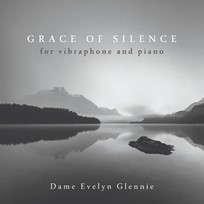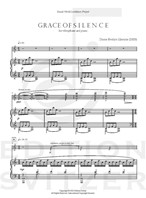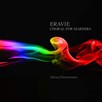
Grace of Silence
Composer: Dame Evelyn Glennie
Instrument: Vibraphone and Piano
Level: Intermediate
Published: 2022
Price: €20.00
Item details
-
Description +
-
Performed and recorded in isolation during lockdown by Harriet Riley (Vibraphone) and Paul Israel (Piano) from The Bristol Ensemble
Preface
Completed on 17th April 2020, Grace of Silence was written in response to a request from Sound World, an organization based in the South of England, to help support local professional musicians’ livelihoods during the first lockdown brought on by covid-19.
This global pandemic brought devastation to many industries including the music world. Lockdown meant that musicians could not travel to perform. This piece is in response to the dramatic changes many of us experienced during lockdown.
The incessant repetitive pattern from the piano depicts a monotonous motif of time being stagnant and going nowhere. The vibraphone tries to bring hope with the ebb and flow of its quasi melodic patterns. The whole improvised section is a reminder of how life was pre-pandemic – full of spring and joy, lots of movement and life until it too gradually becomes more distorted and fragmented, reminding us of the dark cloud the pandemic had imposed on us. The piece ends in such a way that there is a question mark - uncertainty. We had no idea how we would all emerge from this situation or for how long it may take. We were literally suspended.
Dame Evelyn Glennie
-
-
Instrumentation +
-
Vibraphone and Piano
-
-
About the composer +
-
Dame Evelyn Glennie is the first person in history to successfully create and sustain a full-time career as a solo percussionist, performing worldwide with the greatest orchestras, conductors and artists. Evelyn paved the way for orchestras globally to feature percussion concerti when she played the first percussion concerto in the history of the Proms at the Royal Albert Hall in 1992. Evelyn has commissioned over 200 new pieces for solo percussion from many of the world’s most eminent composers to vastly expand the percussion repertoire. She regularly provides masterclasses and consultations to inspire the next generation of musicians. The film ‘Touch the Sound’ and her enlightening TED speech remain key testimonies to her innovative approach to sound-creation.
Leading 1000 drummers, Evelyn had the honour of a prominent role in the Opening Ceremony of the London 2012 Olympic Games.
Evelyn was awarded an OBE in 1993 and now has over 100 international awards, including the Polar Music Prize and the Companion of Honour. She was recently appointed the first female President of Help Musicians, only the third person to hold the title since Sir Edward Elgar and Sir Peter Maxwell Davies.
Evelyn is currently creating The Evelyn Glennie Collection with a vision to open a centre that embodies her mission to Teach the World to Listen. She aims to ‘improve communication and social cohesion by encouraging everyone to discover new ways of listening as proven in her book ‘Listen World!’. We want to inspire, to create, to engage and to empower’.
-
-
Reviews +
-
Review (Percussive Notes, June 2024)
Dame Evelyn Glennie has a talent for composing musical ideas that are interesting, and evocative. Much like her three chorales, “Grace of Silence” draws strength from its simplicity both in thematic material as well as in its performing forces. The intention behind this simplicity takes on broader significance as “Grace of Silence” was written to raise money and increase public awareness of the plight faced by local professional musicians in southern England during the global pandemic.
In around eight minutes, Glennie composes a narrative around the inner dialogue many people faced during Covid-19 related lockdowns. In the beginning of “Grace of Silence,” Glennie presents a stable and predictable theme in the piano that is periodically disrupted by the vibraphone. This relationship is intended to portray the mundanity of the passing of time, while the vibraphone represents hopefulness. In its middle section the piece departs from its more prescriptive dialogue and moves to an improvised section where a tonal soundscape is established and then gradually destabilized until lastly it returns to the plodding opening theme in the piano, representative of the unknowing of the situation.
The vibraphonist will need four mallets and one or two bows. While the pianist will not require extended techniques, that player is asked to maintain an ostinato in the left hand while improvising in the right hand. Glennie provides sample ideas of useful figures to guide improvisations as needed.
Composed under unique circumstances, “Grace of Silence» is best suited for a situation where two performers must perform virtually; however, it could be beneficial for any scenario where two performers are looking to program a piece with limited rehearsal time. Congratulations to Dame Glennie on this unique addition to the repertoire!
—Quintin Mallette
-
-
Credits +
-
Artist: Johan Peijnenburg
Site: NiO Photography
Address: https://www.niophoto.com
Photo: Jim Callaghan
Engraving: CPH Engraving
Printed in Copenhagen, Denmark
Copyright © Edition SVITZER
www.editionsvitzer.com
-




